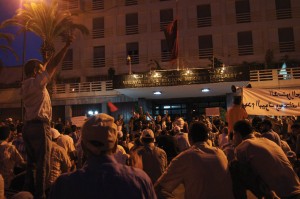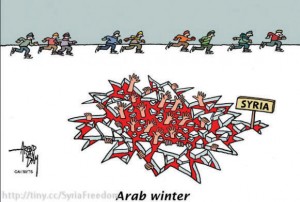A series of anti-government revolutions in Western Asia starting in 2010 has been all about democracy. Nisarg Kamdar introduces the Arab Spring and analyses why power to the people has become an issue of paramount importance
The Arab Spring has for the past thirty six months catalysed a paradigm-altering scenario in the world of geopolitics and international security, but for many it still remains an incomprehensible occurrence, a thing of a customary Facebook share or sympathetic retweet. But beyond the oceans of ink spewed by the media, claiming the Arab Spring as a personal triumph, there is a story of the collective struggle of a region against dictatorship and tyranny.
WHAT IS THE ARAB SPRING?
The Arab Spring is a term that represents a period wherein extraordinary pro-democracy rebellions and demonstrations flared up across Western Asia. It implies a decisive Arab mobilisation towards a more liberal and self-determined (democratic) regime.
THE FIRST FLARE
The revolution began when a young Tunisian graduate, Mohamed Bouazizi, reduced to unskilled labour due to a lack of jobs in Tunisia, set fire to himself on 17 December 2010. He was protesting after police confiscated the fruit and vegetables he was selling from a street stall. The police’s high-handedness was hardly a surprise in a nation used to such blatant misuse of power and official position.
There was already wide discontent simmering over the deterioration of employment prospects in the region, the rising gaps in income levels and the misrule of the local government. This act of brute force seemed to capture the imagination of the people, and the anger and resentment boiled over to the streets with vociferous protests. It is interesting to note that Wikileaks cables documenting widespread political corruption, human rights violations and the accumulation of wealth in the laps of autocrats were released just weeks before the protests broke out.
FANNING THE FIRE
Ten days later, Tunisia’s leader, Zine el Abidine Ben Ali threatened a crackdown against violent protests while in the same breath promising more jobs. That hardly seemed to calm protestors, who only took it as an opportunity to intensify their protests against high food inflation, poor living conditions and a suffocating political cauldron. Their efforts bore rich dividends when the establishment cracked under relentless protests and tacit support for the protestors from superpowers like the United States. Ben Ali, whose family was colourfully described as “quasi mafia” by one Wikileaks cable, fled with his family and took refuge in Saudi Arabia. This led to an extraordinary uprising which The Guardian newspaper described as “an earthquake.”
Ben Ali, who had been in power since 1987, though technically elected, had managed to establish a stronghold on the President’s post through a highly oppressive political environment that was terribly hostile to any opposition and dissent. He had invested massively in propping up the number of university and college places to ensure that young Tunisians proceeded to some semblance of higher education. Job creation and economic activity, though, had been far lagging, translating into a 30% unemployment rate for those between 15 and 29.
This is a common thread linking the affected countries. Growing living standards and literacy rates have led to a mismatch between educational growth and economic growth.
CONTAGIOUS SPRING
The fire lit in Tunisia spread fast across the region. Self-immolation protests proliferated through Egypt, Algeria, Libya and Yemen as anti-government activists called for a nationwide ‘day of anger.’ Egyptian President Hosni Mubarak ordered tear-gassing and beatings, and hundreds, including foreign journalists, were arrested. He also attempted to squeeze communications by censoring the media, especially social media which had been employed beautifully by opposition groups to organise and coordinate protests. Egyptian dissident Mohamed ElBaradei, a former head of the International Atomic Energy Agency (IAEA) and a 2005 winner of the Nobel Peace Prize, returned to the country to join the protests, representing the strongest intervention against the country’s authoritarian government. However, ElBaradai has been referred to as Washington’s man – one who would deliver a government palatable to the folks across the pond and establish a liberal system deriving its fundamentals from Western principles of governance and democracy. The Mubarak government was decapitated by twin strikes within a couple of weeks. First, the Egyptian army endorsed what it called the “legitimate” demands of the people by assuring that there will be no use of force to silence “our great people”. Secondly, major European powers and the United States aligned themselves firmly on the side of the public by praising the protestors as “having exercised their right to peaceful assembly”.
The Mubarak government crumbled under the sustained onslaught from a million protestors gathered at Tahir Square, and on the historic day of 11 February 2011, announced he was stepping down and transferring power to the military.
IN A STATE OF FLUX
The present status of the rebellion is at best messy. The democratically elected government of Egypt, one dominated by the Muslim Brotherhood, has been overthrown by the Egyptian military. The pro-Islamist constitution has been suspended and Hazem Abdel Aziz Al Beblawi has been pointed as the interim PM. Fresh elections have been called but are yet to be held and this places Egyptian democracy in a perilous position. On the other hand in Syria, there is a bloodied civil war in progress. The United Nations, dominated by petty politics and parochial interests, has been unable to participate with a decisive intervention. Rather, the death toll just keeps mounting.
WORTH IT?
The grinding question remains – has the Arab Spring left a progressively indelible mark on the fate of Middle Eastern politics or has it made the security situation in the region more perilous?
While the profound message at the heart of the Arab Spring is heartwarming and of noble intent, one can’t help feeling something somewhere has gone terribly wrong. The Middle astern security situation is feebler than ever, the Al-Qaeda has been resurgent in the region, there is a serious problem of unaccounted small arms and light weapons circulating in the region. One can only hope that the international community is able to collectively dismantle these threats. The Arab Spring carries with itself a message of hope, political equality and self-determination, and has enshrined democratic principles in some countries. But in this period of transition remains a glaring vulnerability which remains open to exploitation by nefarious elements and it is in the interest of humanity to guard against these with grit and determination.
FAILED PROTESTS
SAUDI ARABIA
The Saudi Arabian Royal family successfully clamped down on sectarian clashes by the brute and unrestrained use of forces. In the face of such savagery the protests fizzled out fast. However, King Abdullah has agreed to some economic concessions.
IRAN
Various opposition groups held peaceful protests, but the government responded with force and violence, arrested the opposition leaders and made no concessions.
ALGERIA
President Abdelaziz Bouteflika, ruler since 1991, held on to his post. He lifted the State of Emergency that had lasted for 19 years and made some political concessions, but is still deeply embedded into Algerian politics.
Volume 3 Issue 6































